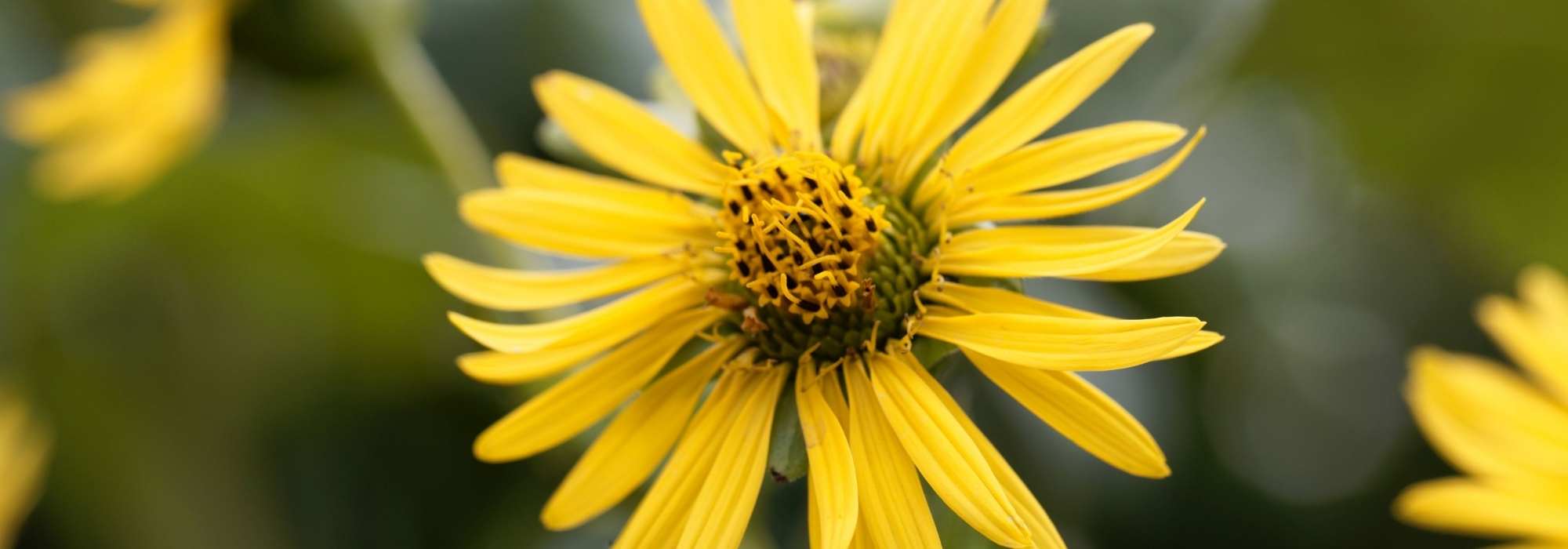
Silphium: planting, growing
Contents
Silphium in a nutshell
- It is one of the largest perennial plants!
- From summer to autumn, Silphium produces large yellow daisy-like flowers reaching nearly 3 metres high.
- Easy to grow, it thrives in full sun in rich, cool soil.
- Vigorous and long-lived, it is perfectly hardy in all our regions.
- It adds a rustic touch to borders, large wild spaces, and natural meadows.
A word from our expert
Iconic plants of the fertile wet meadows of North America, Silphiums (S. laciniatum and S. perfoliatum), also known as silph or silphon, are large, vigorous perennials that form immense flowering clumps reaching up to 3 metres in height.
Majestic, they reward us with their melliferous and sunny flowering, showcasing large bright yellow daisies from June until the frosts. Additionally, they make beautiful cut flowers!
These giant perennials, belonging to the same family as sunflowers but perennial, combine hardiness and floribundity, requiring only sunlight and fresh soil to thrive.
Particularly robust and needing very little maintenance once well established, perfectly hardy, let yourself be tempted by these beautiful Americans with their graphic appearance and rustic charm!
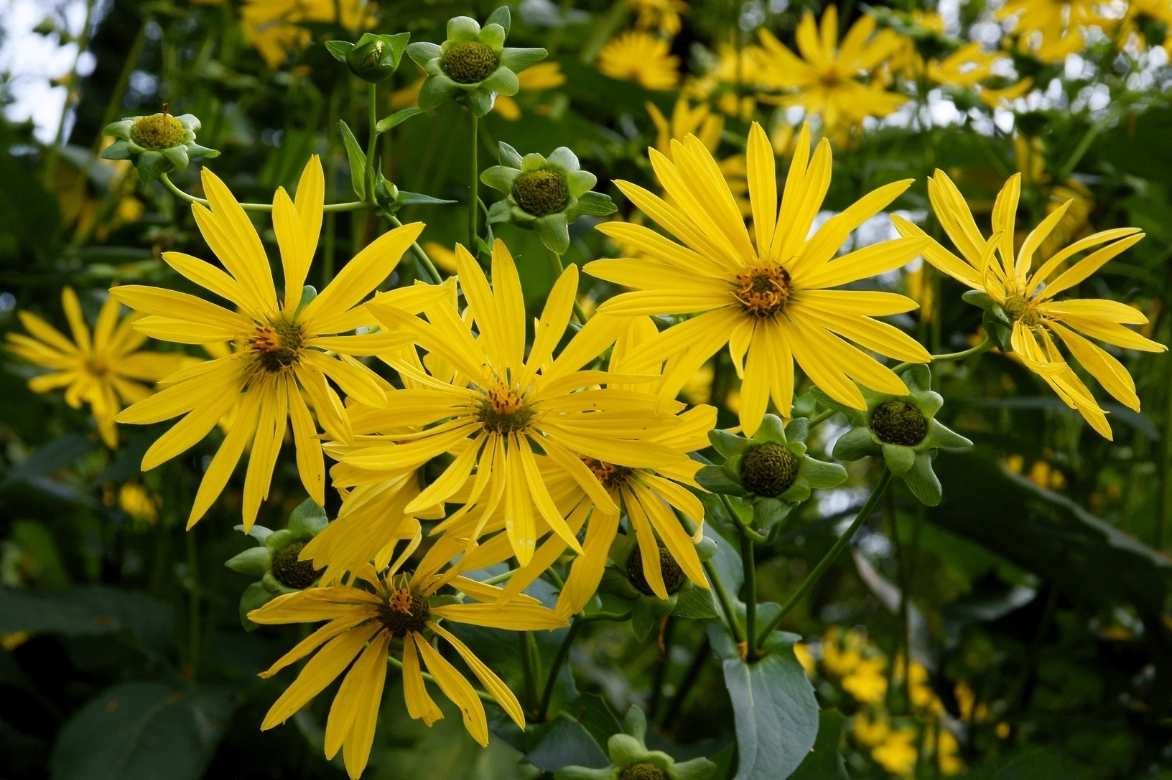
Silphium perfoliatum
Description and botany
Botanical data
- Latin name Silphium
- Family Asteraceae
- Common name Silphium, Silphion, Cup plant
- Flowering June to November
- Height 2 to 3 m
- Exposure Sun
- Soil type Rich, cool, well-drained
- Hardiness -15 °C and beyond
Silphium, commonly known as cup plant, is a large perennial plant from the Asteraceae family, which includes asters, echinaceas, rudbeckias, and other daisies. The genus Silphium comprises about 17 species of herbaceous perennials native to the wet meadows and edges of North America. In our gardens, only two species are represented:
- Silphium laciniatum, better known as the “compass plant” because its leaves orient themselves according to the rising sun, on a North-South axis.
- Silphium perfoliatum or Silphium or perfoliate silphion
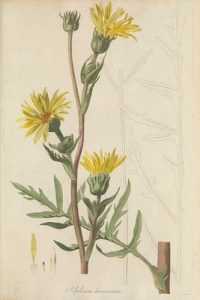
Silphium laciniatum: botanical plate (circa 1811)
Silphium is a species currently endangered in its native regions due to habitat degradation.
This robust perennial can easily reach up to 3 m in height, with a spread of 70 cm to 1 m. From a taproot, it develops a rosette close to the ground. The plant forms a bushy tuft with an upright habit. A bit slow to establish, it takes about two to three years for Silphium to grow vigorously and produce its first flowers. This slowness is matched only by its great longevity, as it can live for nearly a hundred years.
In spring, few branched, rough, quadrangular stems emerge from the rosette. These stems are aromatic, possessing a turpentine-like scent. They bear large, green, deciduous leaves that are oval to triangular, lanceolate, with a regularly dentate edge, and opposite up to the top of the stems. They measure from 4 to 60 cm long and up to 30 cm wide. Their size decreases as they rise along the stems. They sheath the base of the stems, retaining rainwater or dew, which has earned the plant the lovely nickname “bird bath,” as birds and insects come to drink from it.
The foliage varies from one species to another. In Silphium perfoliatum, the stems seem to pierce through the leaves, hence its Latin name meaning “through the leaf.” Silphium laciniatum is distinguished by its leaves that orient themselves within two to three weeks, according to the rising sun, towards the North or South. It has been given the other name of “compass plant” because this feature is said to have guided settlers during the westward expansion. This property protects them from sunburn and limits water evaporation in the leaf tissues.
From this abundant and rough vegetation rise the flowering stems from July to October, blooming until the first frosts. The summer flowering occurs in the form of terminal corymbs composed of large heads, resembling small sunflowers, large daisies, or even the flowers of Jerusalem artichoke.
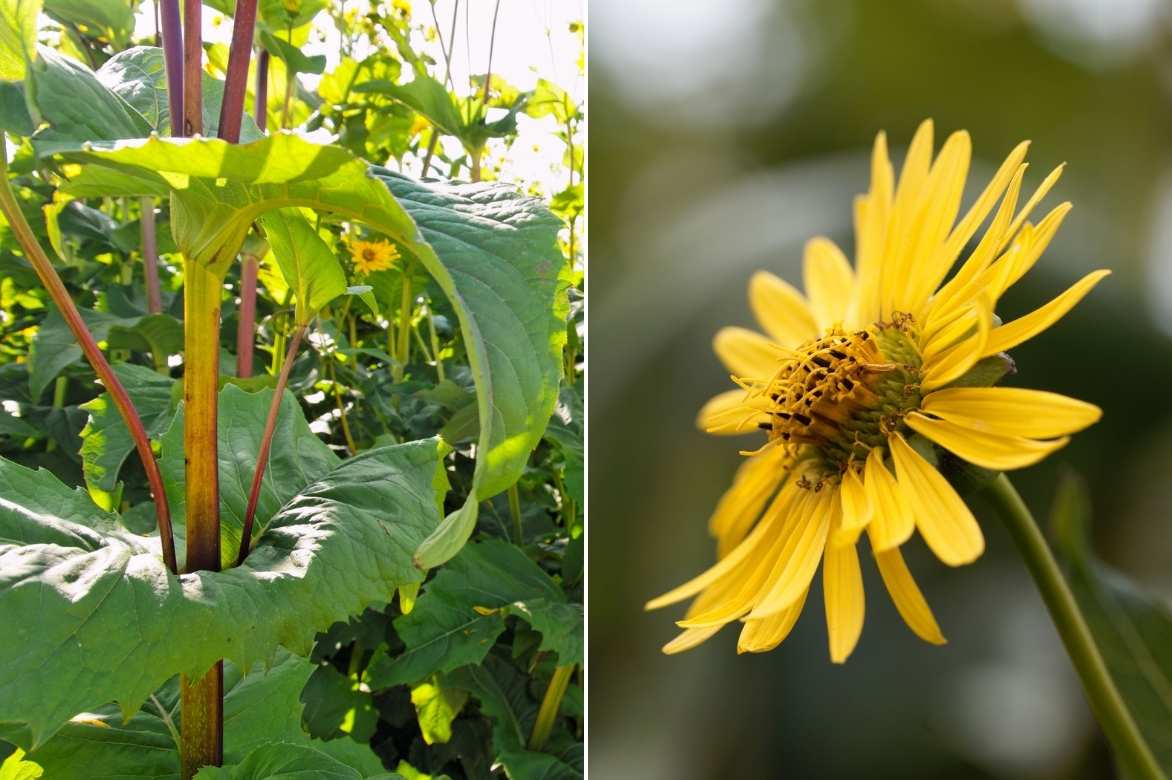
Silphium perfoliatum: leaves and flowers
The heads, containing 27 to 38 flowers, appear at the tips of the leafy stems, often reaching nearly 3 meters high. These inflorescences oriented towards the sun measure from 4 to 10 cm in diameter. They are characteristic of the Asteraceae family and consist of large thread-like yellow ligules arranged radially around a heart of florets, yellow speckled with black stamens.
Their radiant presence enhances summer and autumn bouquets.
Nectariferous and melliferous, they renew continuously throughout the summer, attracting foragers and pollinators late into the season. These flowers then produce fruits that will nourish birds in the dormant season and self-seed easily.
The Cyrenaican silphium was a medicinal plant now extinct, whose stems exuded a bitter juice with medicinal properties used in antiquity and by Native Americans and settlers.
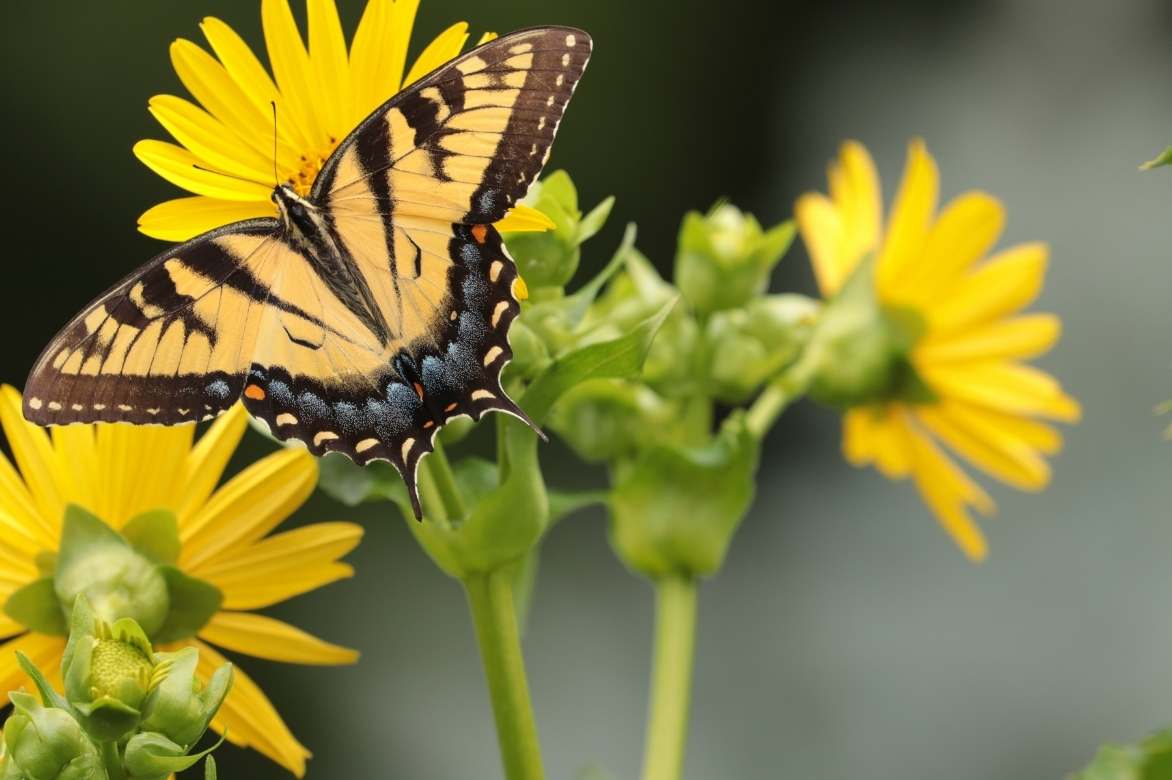
Silphium perfoliatum
“`
Main species and varieties
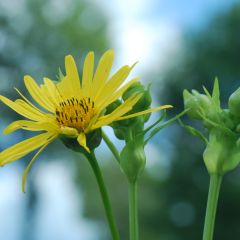
Silphium laciniatum
- Flowering time August to November
- Height at maturity 3 m
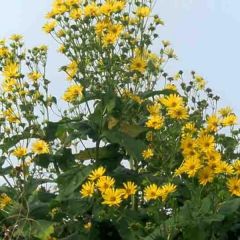
Silphium perfoliatum
- Flowering time August to October
- Height at maturity 2 m
Discover other Silphium
View all →Available in 1 sizes
Available in 1 sizes
Available in 1 sizes
Available in 1 sizes
Planting Silphium
Where to plant?
Easy to grow, Silphium is perfectly hardy down to at least -20°C. This large daisy prefers full sun (at least 8 hours of sunlight per day for optimal flowering), tolerating partial shade in the warmest regions of our country. Provide it with a clear spot to reach its full potential, sheltered from strong winds that may bend its tall stems.
Tolerant, while it accepts ordinary soils, even calcareous or dry once well established, it will be more floriferous in fertile, well-draining soil that remains cool to moist in summer. In poorly drained soil, it will be susceptible to winter flooding.
Choose its location carefully as its taproot dislikes being moved, and ensure it has enough space as it can grow up to nearly 3 m in height. It establishes slowly but eventually forms dense, highly floriferous clumps over time, returning faithfully each year.
With its tall stature, it will majestically dominate the backgrounds of naturalistic beds or punctuate flowering meadows or rustic corners by forming thickets. It can also bloom against a well-exposed wall. With its candid and sunny flowering, it helps to structure wild-looking scenes with ease. Its enormous dimensions and vigour make it unsuitable for pot cultivation.
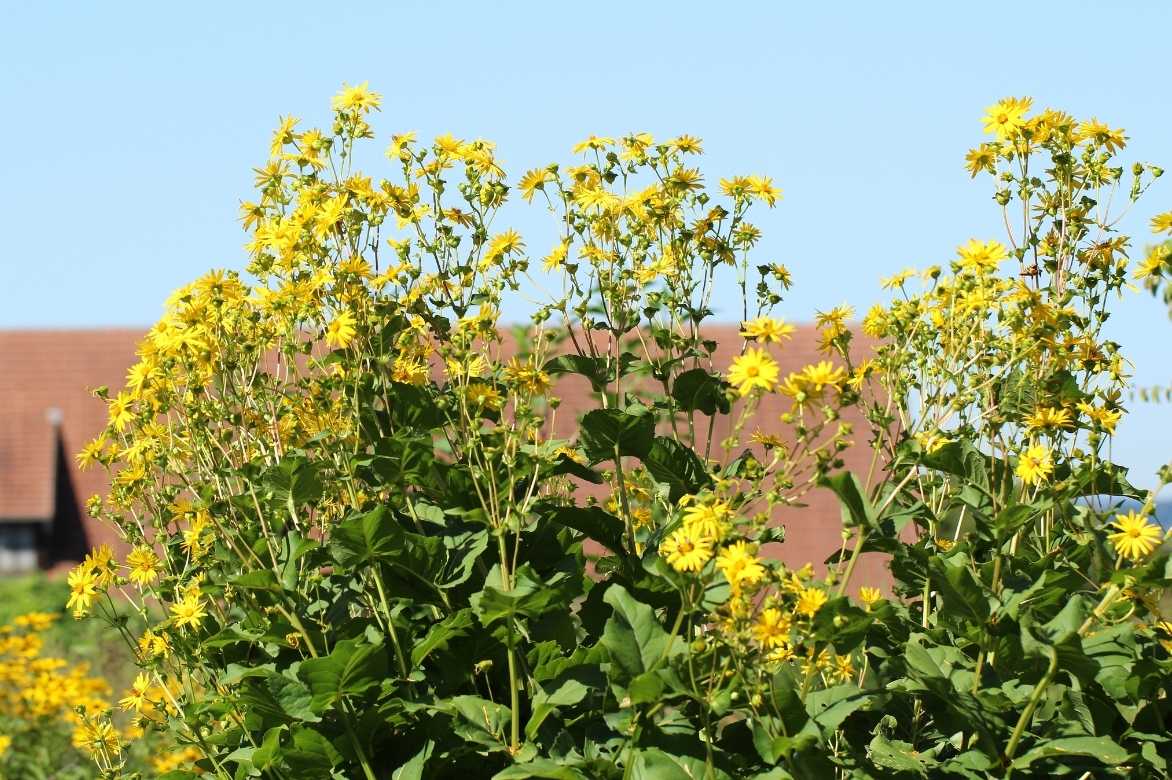 Siphium laciniatum
Siphium laciniatum
When to plant?
Planting Silphium is done in spring, in March or April, while monitoring watering closely, or in autumn from September to November, avoiding periods of frost or drought.
How to plant?
A rich soil will promote beautiful flowering: improve the soil by adding a few handfuls of good mature compost. Count on 2 to 5 plants per m², maintaining a distance of about 50 cm between plants for a charming and rustic display. You can plant it in thickets, alone, or mixed with other perennials or giant grasses.
- Dig a hole 2 to 3 times the volume of the Silphium root ball, at least 30 cm deep
- In heavy soil, improve drainage by spreading a layer of gravel or clay pebbles at the bottom of the hole
- Add one or two handfuls of compost and a bit of river sand to the garden soil
- Fill in with this mixture
- Water
- Mulch to keep the soil cool during summer
Growing and care
Once well established in the sun and in well-drained soil, Silphium becomes more opulent each year without requiring much maintenance.
In the first summer, water regularly but not excessively, as the root should remain cool, not waterlogged. Subsequently, the plant will tolerate short periods of drought. Mulch the stump during summer with compost or an organic mulch to keep the roots cool and reduce watering.
In spring, add one or two shovelfuls of compost to nourish the root.
The clumps are sturdy enough to stand without supports, although they may tend to lean under the effect of wind or rain.
Remove faded flowers as they appear to encourage the emergence of new flower buds.
After flowering, cut the clump back to ground level. The foliage disappears in winter, reappearing in spring.
Multiplication
Silphium multiplies easily by clump division in spring or autumn from well-established stumps less than 3 years old. Division helps to rejuvenate the plant and quickly produces new plants identical to the original species. It also self-seeds spontaneously.
- Lift the clump with a fork
- Divide into several pieces with roots and leaves
- Replant immediately in the garden in well-drained, cool soil, then water regularly to ensure establishment
Pairing ideas
With its tall and structured silhouette, and its numerous bright yellow daisy-like flowers, Silphium is perfect for brightening large spaces and slightly wild flowerbeds in a natural garden.
It always brings a lot of vitality, lightness, and cheerfulness to pastoral and naturalistic scenes at the end of the season. Imposing, it is often planted at the back of a flowerbed, either alone or grouped, to punctuate a flowering meadow where it easily surrounds itself with other perennials that are just as undemanding as it is.
In a richly flowering bed, it will accompany summer-flowering perennials in vibrant colours such as Cosmos, dahlias, and Gladiolus, Coreopsis, Kniphonias, and Echinaceas. Consider planting it near other robust perennials like Asters, Cannas, and Daylilies, as they will provide support, preventing its stems from flopping over in the bed. Also surround it with autumn-flowering perennials such as autumn Heleniums and Chrysanthemums.
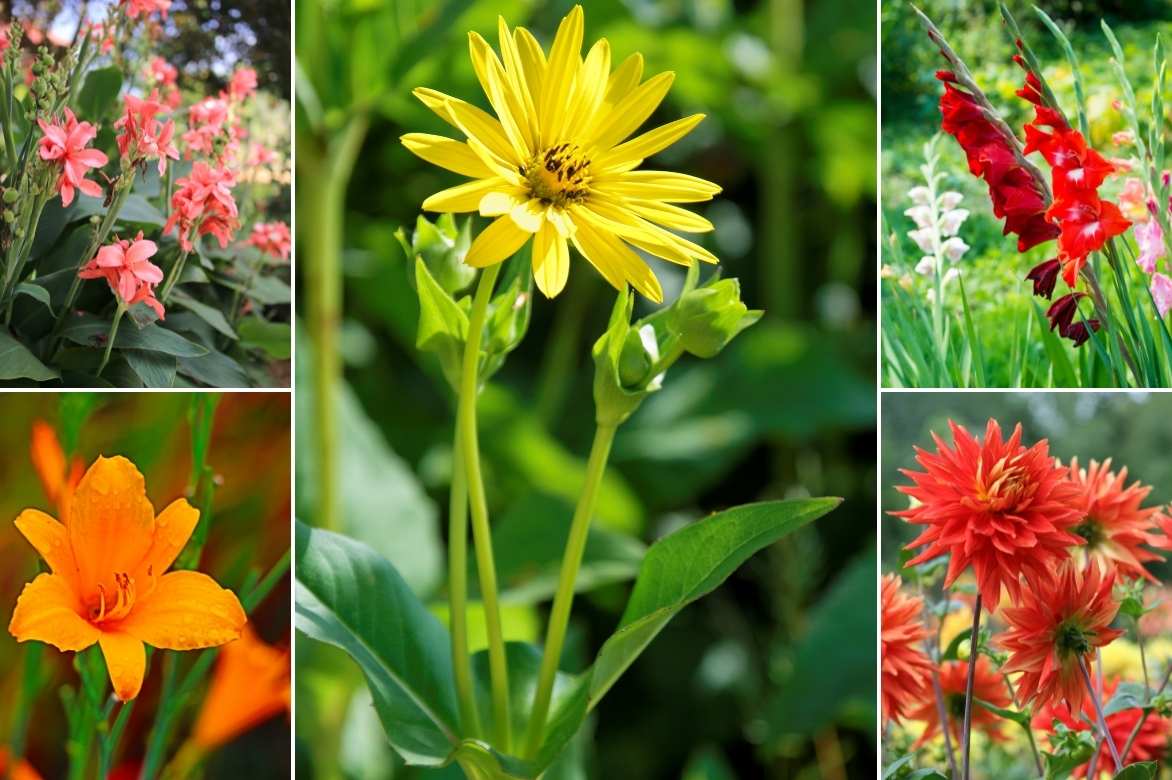
In a summer bed, radiant Silphiums alongside lush Cannas and Daylilies, Gladiolus, and dahlias
In a naturalistic meadow, it will have companions such as Leucanthemums, large perennial sunflowers, Buenos Aires Verbenas, and tufted canches.
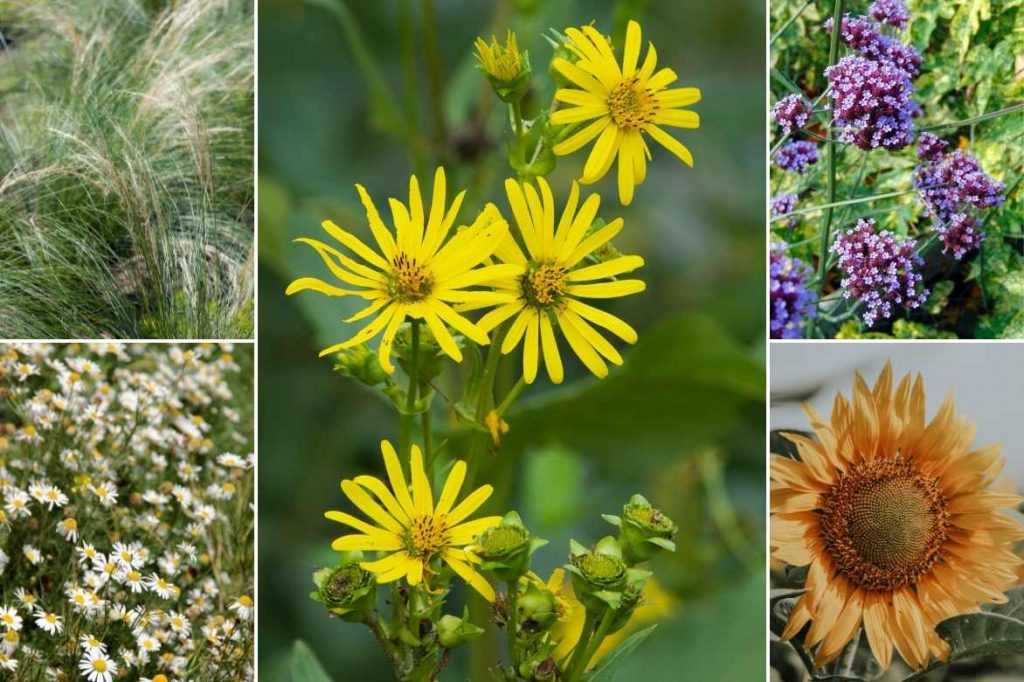
Silphiums, tufted canche, Leucanthemum, Verbena bonariensis, and sunflower
To create complementary colour games of yellow/blue, pair it with the blue blooms of Céanothes, Siberian Salvias, and Echinops or globe thistles, for example.
To brighten a large open and sunny space, Silphium will fit perfectly within a profusion of tall grasses such as Pennisetum, Stipa pennata, Hordeum jubatum, or Cortaderia or Pampas Grass.
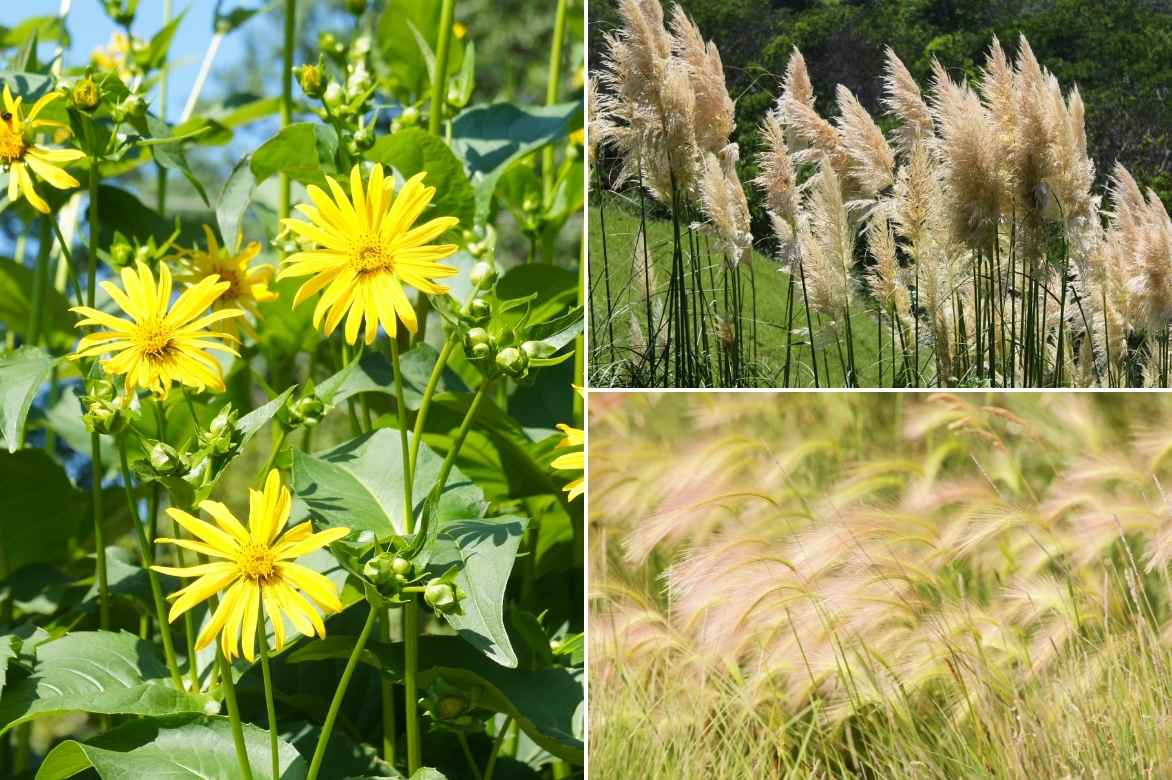
Association of Silphiums with Cortaderia selloana and Hordeums jubatum
Useful resources
- Sylphium are perfect for a low-maintenance garden; discover which plants to pair them with for a country house vibe or in a sunny naturalistic meadow.
- They fit perfectly into naturalistic gardens; get inspired by our ideas on our blog!
- Learn how to temper yellow flowers in the garden and embrace them!
- Discover our collection of late-flowering perennials to extend the beautiful season into winter.
- Subscribe!
- Contents


































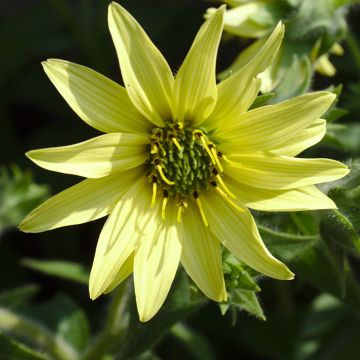
Comments